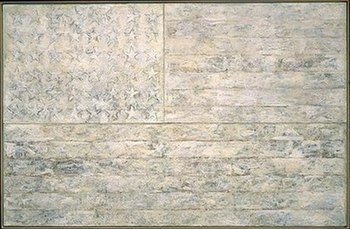White Flag is an encaustic painting by the American artist Jasper Johns. Created in 1955, soon after his first flag painting, entitled simply Flag, it was the first painting by Johns to be acquired by the Metropolitan Museum of Art, in New York, bought from the artist in 1998. The price was undisclosed but experts estimated its value at the time as more than $20 million.
| White Flag | |
|---|---|
 | |
| Artist | Jasper Johns |
| Year | 1955 |
| Medium | Encaustic |
| Dimensions | 198.9 cm × 306.7 cm (78.3 in × 120.7 in) |
| Location | Metropolitan Museum of Art, New York |
The painting is a relatively early example of the many works created by Johns from 1954, inspired by a dream of the U.S. flag. Painted on canvas using encaustic, oil, newsprint, and charcoal, White Flag is the first monochrome rendering of the US flag by Johns. Measuring 198.9 centimetres (78.3 in) by 306.7 centimetres (120.7 in), it is also the largest of his flag paintings.[1]
Johns worked on three separately stretched areas of canvas—the 48 stars to the upper left, seven of the thirteen stripes to the upper right, and the remaining six longer stripes below—which were then combined to form a whole. The U.S. flag is depicted in the form it took between 1912 and 1959, with 48 white stars on a blue canton representing the then U.S. states (prior to the admission of Alaska and Hawaii) with thirteen red and white stripes. The stars and stripes are built up as a collage of paper and fabric which were dipped in molten beeswax before being applied to a ground of beeswax. The three collages were then joined together and covered with a layer of fast-setting dirty white encaustic (beeswax mixed with white pigment), with highlights added in white oil paint. Johns's rapid brushstrokes are clearly visible in the roughly-finished encaustic medium. The completed work covers the whole of the canvas, with no frame.
Johns's selection of the US flag allows him to explore a familiar two-dimensional object, with its simple internal geometric structure and a complex symbolic meaning. The built-up collage distorts the flags flatness, while the off-white encaustic obliterates the flag's usual red-white-and-blue colouring, leaving a ghostly embalmed remnant. Johns' Neo-Dada work anticipates aspects of pop art, minimal art, and conceptual art.[citation needed]
The 1988 Christie's auction, selections from the Tremaine Collection, a smaller version of White Flag sold for USD$7 million, and was briefly the highest auction price for an artwork by a living artist, [2] until it was exceeded the next day by Johns' False Start. [3] (Regarding the smaller version, note the difference in artwork size, exhibition histories, and ownership over the years of the two works, referring to the Met webpage for the larger 'White flag'.) This smaller version was shown in photographs by Louise Lawler documenting the artwork owners' interiors and its appearance in the 1988 auction. [4]
Notes
edit- ^ The Metropolitan Museum of Art Guide. Metropolitan Museum of Art. 2012. p. 424. ISBN 978-1-58839-455-2.
- ^ Reif, Rita (November 10, 1988). "Johns's 'White Flag' Is Sold for Record Price". The New York Times. ISSN 0362-4331.
Jasper Johns's ghostlike 'White Flag,' ... was sold last night at Christie's for $7 million, the highest price ever paid for a work by a living artist.
- ^ Reif, Rita (November 11, 1988). "Jasper Johns Painting Is Sold for $17 Million". The New York Times. ISSN 0362-4331.
The sale at Sotheby's ... exceeded many of the records set Wednesday night at Christie's. Johns's 'False Start' was sold for $10 million more than his White Flag had brought at Christie's, establishing a new high for a work by a living artist.
- ^ (March 15, 2019). Jasper Johns. 'White flag', (1955-58). 'artdesigncafe'. Retrieved September 16, 2021.
References
edit- White Flag, Metropolitan Museum of Art
- White Flag, Metropolitan Museum of Art
- Met Buys Its First Painting by Jasper Johns, New York Times, 29 October 1998
- American Culture in The 1950s, Martin Halliwell, p.203–205